How to clean the sink from plaque: a review of effective
Any plumbing equipment that comes in contact with tap water is inevitably covered by various sediments. The sink is most vulnerable in this respect, since it constantly evaporates cold and hot water with detergents, food residues and other substances dissolved in it.
We will tell how to clean the sink from limescale most effectively.
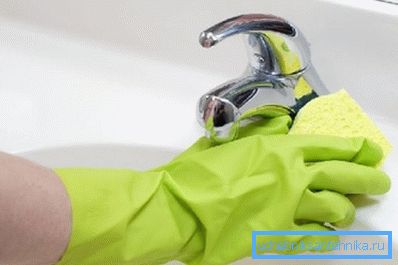
Limescale
Causes
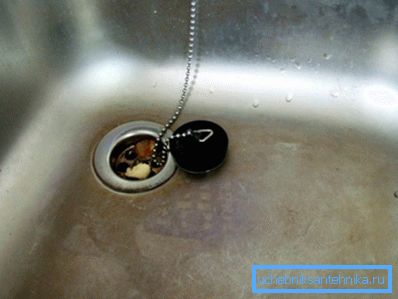
One of the most common types of pollution on the surface of sinks and baths is the deposition of mineral salts of lime origin.
Since the majority of apartments and houses are connected to a centralized hot and cold water supply system, the problem can be considered universal and widespread.
The main cause of lime deposits is high hardness of water supplied to the water supply system. What does this mean?

Water hardness is a combination of properties of a chemical and physical nature, directly related to the content in the water of the so-called hardness salts, or salts of alkaline earth metals. Mainly, we are talking about compounds of calcium and magnesium.
In the process of interaction of water with the surface of the sink, as well as as a result of chemical processes of interaction with detergents, food debris and other chemicals, some of the salts dissolved in water settle on the surface of the sanitary fixture. After drying, these sediments become stony, forming a solid opaque patina of white or gray color.
Over time, the sediment layer can grow to an impressive thickness. Sometimes limescale closes drains or openings of taps, but even in less neglected forms it spoils the appearance of plumbing and deprives it of its usual brilliance and beauty.
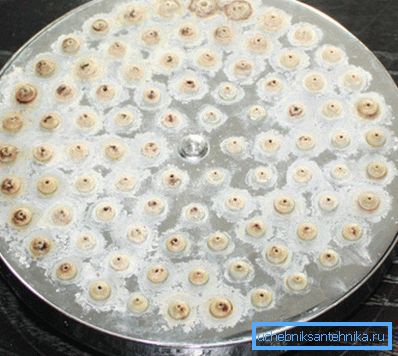
Note! In addition to the aesthetic harm that plumbing causes limescale plumbing, it can also become an environment for the development of harmful and pathogenic bacteria, mold and other unwanted microorganisms.
Cleaning methods
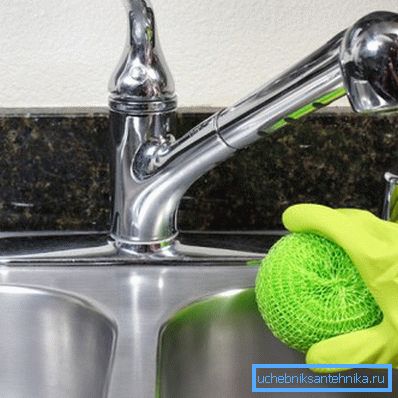
So, we were convinced that the problem of lime deposits is relevant for almost all plumbing fixtures, and sinks are at special risk. Now we will tell you how to get rid of the lime scale on the sink.
The principle of sediment control is simple and based on the chemical properties of the salts that form the plaque. These salts are alkaline in nature, and therefore they interact with acids, which, as a result of the reaction, neutralize and decompose deposits.
You can use these tools:
- Acetic acid. This is the most common reagent in everyday life, which is quite safe for health and as accessible as possible. Both the diluted to 9% form and the essence can be used, however it is better to dilute the concentrate in order to avoid burns and damage to the enamel;
- Lemon acid. It is also quite affordable and common substance, while it is even more secure and has the most gentle effect. Usually, the powder is applied to a damp cloth and rubbed on the surface: this is a double effect, chemical and abrasive;
- Ammonia or ammonia. Sold in pharmacies, the price is available to everyone. It has a whitening effect, but it has a strong unpleasant odor that can harm the mucous membranes of the nose, throat and eyes.

Depending on the degree of contamination, one or another acid is selected. The most benign and harmless is citric acid. For more stable deposits, it is better to use vinegar, and to increase the activity it can be heated to 40 - 50 degrees.
The cleaning procedure is simple: we moisten the sponge in the prepared solution and apply it on the contaminated surface, rubbing it thoroughly. Leave the sink in this form for 30 - 60 minutes, then wash the solution together in bloom with cold water.

Note! When working with acids, hands should be protected with rubber gloves, and also not to allow the solution to get into the eyes and mucous membranes. In case of damage to eyes or skin with acid, it should be washed off with plenty of running cold water.
Rust and other types of pollution

In addition to salt deposits, yellow and brown spots are often observed on the surface of the shells. These are pollution left by rust. They arise as a result of corrosion of pipes and steel taps, as well as due to particles and iron salts dissolved in water.
To get rid of rusty plaque, you can use vinegar.
However, for greater efficiency, it is better to use the combined means that are easy to prepare with your own hands:
- Option One - This is a mixture of 9% wine vinegar with table salt. On a glass of vinegar add half a tablespoon of salt and heat to a temperature of 50 - 60 degrees. We close the drain hole of the sink with a stopper and pour the solution, wait half an hour and then wash it along with rust down the drain;
- Option Two - This is the use of soda and vinegar. We first apply a layer of paste-like soda (baking soda + warm water), then, after 15 minutes, spray it with vinegar from a spray bottle. We are waiting for half an hour and rinse with cold water.
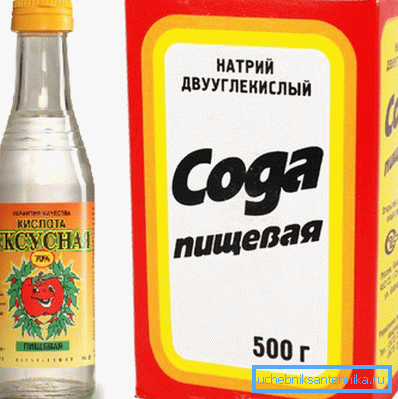
How to wash the shell from the plaque, if the funds listed did not help? There is one effective remedy.
Instructions for its preparation and use are as follows:
- We buy in the hardware store universal solvent 646 or similar. Pure acetone can be used;
- We take a pack of starch, and knead with a solvent to a state of gruel;
- Apply the paste to the surface of the sink and leave for half an hour;
- Rub the surface with a sponge and wash the solution with cold water.

Note! When working with solvents, the room should be aired as much as possible, since its vapors are very toxic. You should also protect your skin with rubber gloves.
Conclusion
If your sink has lost luster and has become covered with bloom - do not rush to run for expensive advertised means. At home, you can prepare at least effective solutions, the use of which gives an excellent result (see also the article How to clean the sink with artificial stone and features of its care).
The video in this article will help you master the methods of making such tools and plumbing cleaning methods.